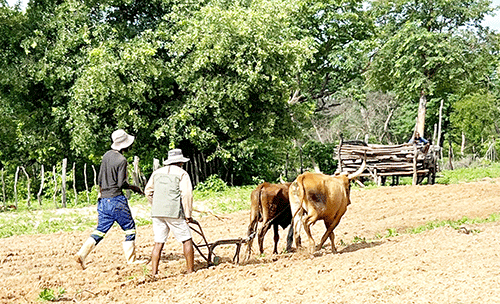Victoria Immanuel and Lahja Nashuuta
ELIM – After enduring consecutive seasons of harsh droughts, subsistence and communal farmers in northern Namibia are celebrating the recent arrival of much-needed rains.
The recent rains have also led to an increase in the capacity of vital dams around the country. In the northern areas, subsistence farmers are hoping that the pattern is sustained for better yields and grazing pastures. The rain has rejuvenated their lands and reawakened hope for a prosperous agricultural season.
The erratic and limited rainfall distribution patterns experienced since the start of the agricultural season in 2022, resulted in abnormal dry conditions.
This affected most parts of the country and resulted in both poor crop yields and reduced rangeland conditions.
The Namibia Meteorological Service has however, forecasted normal to above-normal rainfall for the 2024/2025 season, particularly benefiting the central and northern regions.
This positive outlook has prompted farmers to prepare their fields and plan for a productive season.
In the Oshana region, farmers have started ploughing and planting staple crops such as mahangu and sorghum.
“The recent rains have softened the soil, making it ideal for planting, we are optimistic that this season will yield a good harvest,” said farmer Johannes Amutenya.
Livestock farmers are also optimistic, expecting improved grazing conditions that will bolster livestock health and productivity.
“This is a significant relief after the hardships we’ve faced. The pastures are improving, and our cattle have access to better grazing,” noted farmer Maria Kambonde from the Omusati region. Pensioner Maria Shiningayamwe (99) from Elim village, encourages farmers to use this opportunity before it is too late, as the weather is unpredictable.
Meanwhile, some farmers are also concerned that should the rainy season be short-lived, their seedlings will die, and the ploughed land might dry up, putting added strain on the farmers to re-plough.
“With the rains that fell over the past days, I have thought of ploughing, but at the same time worried that the crops could die if the rain is not consistent over the coming weeks,” she said.
The Namibian government and various agricultural organisations are supporting these efforts by providing training and resources to help farmers adapt to changing climatic conditions.
Dams and reservoirs across the country have received good inflows over the past few days, NamWater has announced.
In its weekly dam bulletin, NamWater said positive inflows have been recorded in key dams, boosting water security for households, agriculture and industries.
According to the report, the Swakoppoort Dam is currently at a capacity of 24.4%, up from 15.9%, while water level at the Von Bach Dam is currently at 23.5% , an increase from 10.7%. The Omatako Dam is currently at 2.4% while the water level at the Hardap Dam has increased from 5.5% to 14.8%.
According to NamWater, Hardap Dam received the highest positive flow of 27.419 million cubic meters, followed by Neckartal Dam, which saw an increase from 76.8% to 77.8%.
Lot Ndamanomhata, Namwater Head of Public Relations and Corporate Communications, said the developments bring much-needed optimism, as the rainy season progresses, contributing to improved water security for the country.
“NamWater remains hopeful that continued rainfall will further boost dam levels, ensuring water availability for households, agriculture, and industries,” says Ndamonamhata. While the recent rainfall provides relief, NamWater encourages all Namibians to maintain water conservation practices, to ensure sustainable use of this precious resource.


